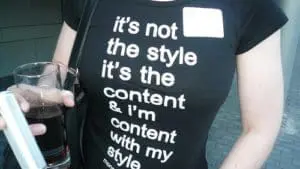
Start with buyer personas
To handle the demands of content creation, marketers have been told again and again to “think like a publisher.” Like publishers, inbound marketers must have a detailed picture of their target audience in order to create optimal content for them. We call this detailed picture a Buyer Persona.
Buyer personas are basically very short stories that answers questions like:
- Who are your ideal customers and prospects?
- What are their biggest concerns, needs, and interest?
- Where can you reach them?
- What kinds of content do they prefer?
For more details on creating buyer personas, read 22 Questions to Ask When Creating Buyer Personas and Creating Buyer Personas for B2B and B2C Companies.
Identify your buying cycle
The content you create helps to generate awareness about your company and converts leads into customers. The type of content you should use to achieve your goals should match each stage of the buying cycle:
Awareness. The prospect gets acquainted with your brand and/or realizes they have a need for your product/service.
Research and Education. The prospect identifies the problem and researches potential solutions, including your product or service.
Comparison and Validation. The prospects examines the options and begins narrowing the list of vendors.
Purchase. The prospect decides to buy from you.
Map your content to the buying cycle
After identifying your buying cycle, you need to map types of content and channels that work best to each stage of the buying cycle. Marketing studies have shown that certain types of content play particularly important roles at specific stages of the decision-making process.
Here’s a suggested mapping of the buying stage to content type:
Once you’ve built your buyer persona(s) and mapped your content around that persona’s buying cycle, it’s time to figure out when and where to use the content you will be creating.
The most effective way to do this is with an editorial calendar.
- Create a Google calendar or spreadsheet to record your editorial plans. Try to plan for three months at a time.
- Work backwards from your marketing goals to guide your plan.
- Fill your calendar with specific dates and publishing tasks, such as updating blog or social networks daily, posting new videos each week, publishing an ebook or hosting a webinar each month, etc.
- Note the SEO keywords, the stage of the buying cycle, the calls-to-action for each piece of content.
- Make note of important dates or external events that are good hooks for specific topics or types of content.
- Look for opportunities to re-purpose content. For example an FAQ could turn into 17 different blog posts, one on each frequently asked question.
- Color code your calendar for each type of content, so you can see at-a-glance when you’re publishing blog posts, webinars, ebooks, videos, etc.
By the end of this process, you’ll find that you’ve filled up most of your calendar with detailed plans for content. This should prevent you from spending hours each day planning your content by providing you with a 3-month content calendar that you simply follow.
2017 Marketing and Editorial Calendar
Successful marketing begins with a plan. Keep track of all your marketing efforts in one customizable marketing & editorial calendar.
2017 Marketing and Editorial Calendar
Successful marketing begins with a plan. Keep track of all your marketing efforts in one customizable marketing & editorial calendar.
